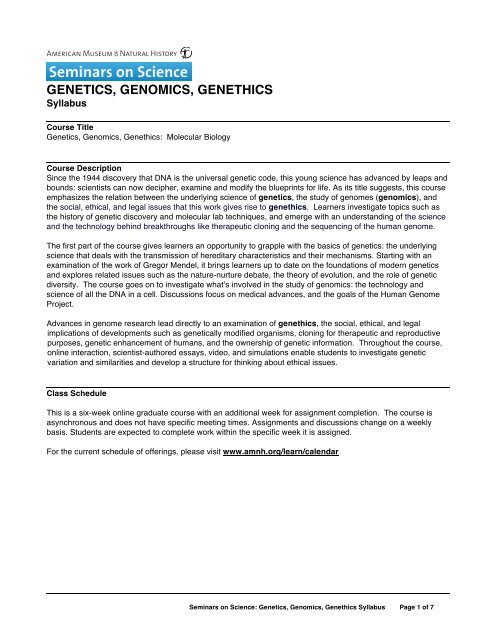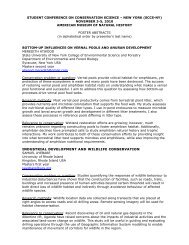Genetics, Genomics, Genethics - American Museum of Natural History
Genetics, Genomics, Genethics - American Museum of Natural History
Genetics, Genomics, Genethics - American Museum of Natural History
You also want an ePaper? Increase the reach of your titles
YUMPU automatically turns print PDFs into web optimized ePapers that Google loves.
GENETICS, GENOMICS, GENETHICSSyllabusCourse Title<strong>Genetics</strong>, <strong>Genomics</strong>, <strong>Genethics</strong>: Molecular BiologyCourse DescriptionSince the 1944 discovery that DNA is the universal genetic code, this young science has advanced by leaps andbounds: scientists can now decipher, examine and modify the blueprints for life. As its title suggests, this courseemphasizes the relation between the underlying science <strong>of</strong> genetics, the study <strong>of</strong> genomes (genomics), andthe social, ethical, and legal issues that this work gives rise to genethics. Learners investigate topics such asthe history <strong>of</strong> genetic discovery and molecular lab techniques, and emerge with an understanding <strong>of</strong> the scienceand the technology behind breakthroughs like therapeutic cloning and the sequencing <strong>of</strong> the human genome.The first part <strong>of</strong> the course gives learners an opportunity to grapple with the basics <strong>of</strong> genetics: the underlyingscience that deals with the transmission <strong>of</strong> hereditary characteristics and their mechanisms. Starting with anexamination <strong>of</strong> the work <strong>of</strong> Gregor Mendel, it brings learners up to date on the foundations <strong>of</strong> modern geneticsand explores related issues such as the nature-nurture debate, the theory <strong>of</strong> evolution, and the role <strong>of</strong> geneticdiversity. The course goes on to investigate what’s involved in the study <strong>of</strong> genomics: the technology andscience <strong>of</strong> all the DNA in a cell. Discussions focus on medical advances, and the goals <strong>of</strong> the Human GenomeProject.Advances in genome research lead directly to an examination <strong>of</strong> genethics, the social, ethical, and legalimplications <strong>of</strong> developments such as genetically modified organisms, cloning for therapeutic and reproductivepurposes, genetic enhancement <strong>of</strong> humans, and the ownership <strong>of</strong> genetic information. Throughout the course,online interaction, scientist-authored essays, video, and simulations enable students to investigate geneticvariation and similarities and develop a structure for thinking about ethical issues.Class ScheduleThis is a six-week online graduate course with an additional week for assignment completion. The course isasynchronous and does not have specific meeting times. Assignments and discussions change on a weeklybasis. Students are expected to complete work within the specific week it is assigned.For the current schedule <strong>of</strong> <strong>of</strong>ferings, please visit www.amnh.org/learn/calendarSeminars on Science: <strong>Genetics</strong>, <strong>Genomics</strong>, <strong>Genethics</strong> Syllabus Page 1 <strong>of</strong> 7
M. Netolický et al.: The circumbinary dusty disk around the hydrogen-deficient binary star υ Sagittarii 831160251401202010015F [Jy]80χ 260104052008 9 10 11 12 13λ [μm]Fig. 3. Spectrum <strong>of</strong> υ Sgr taken with VLT/UTs (points with errorbars),the IRAS LRS (solid line), and SED <strong>of</strong> the best visibility fit model(dashed line). The 30% <strong>of</strong> extra flux <strong>of</strong> the IRAS LRS comes from thewider FOV <strong>of</strong> the IRAS spectrograph.Table 3. Parameters <strong>of</strong> the model <strong>of</strong> the best fit <strong>of</strong> the visibility data andestimated uncertainties. Some parameters are poorly constrained andlack an error bar (see Sect. 3.4 for further details).ParameterValueR in [AU] 6.0 +0.5−1.5i50 ◦+10◦−20 ◦α 2.0 +0.3−0.3β 0.7h 100 [AU] 3.5 +2.0−1.5log(M d /M ⊙ ) −3.5M am.C /M d 0.6 +0.2−0.4adopted the sublimation limit <strong>of</strong> 1500 K for all the models. Wealso kept the outer radius <strong>of</strong> the model grid to R out = 100 AU,which corresponds to the observed diameter <strong>of</strong> 400 mas. This isfully consistent with the image taken with VLT UT telescope,whose shows a perfect Airy pattern, which FWHM is approximately225 mas at 8.7 μm.The geometry <strong>of</strong> the disk is defined by α, β, h 100 , R in ,theinclination i, together with the total mass M d <strong>of</strong> the dust and itscomposition. The fitting proceeded in two steps: in the first step,we focused on finding the best brightness distribution on the sky,i.e. concentrating on visibilities alone, which are influenced bythe geometry <strong>of</strong> the dusty envelope. In the second step, based onthe best models fitting the visibilities, we tried to find the best fit<strong>of</strong> the SED, taking particular care to reproduce the 10 μm silicatefeature.The evaluation <strong>of</strong> the quality <strong>of</strong> the visibility fit was made byusing the reduced χ 2 calculated with the standard equation:χ 2 = 1 nn∑ (V obs,i − V model,i ) 2,i=1σ i2where V obs,i is the observed visibility, V model,i the model visibilityinterpolated to the same wavelength as the one <strong>of</strong> the observedvisibility, and σ i the estimated error <strong>of</strong> the visibility. The parameters<strong>of</strong> the best model are shown in Table 3. The correspondingSED is shown in Figs. 2 and 3. The image <strong>of</strong> the disk given bythe best model is shown in Fig. 6. The fit <strong>of</strong> the observed visibilitiesis shown in Fig. 5.00 20 40 60 80 100 120 140 160 180P.A. [deg]Fig. 4. The χ 2 as a function <strong>of</strong> PA for several models that provide bestvisibility fits.From the analysis <strong>of</strong> the computed models we can put thefollowing constraints on the parameters <strong>of</strong> the model:– R in : the inner radius <strong>of</strong> the dusty envelope is one <strong>of</strong> the mostsensitive parameters. We find that, by using the visibilitiesfit, R in = 6.0 +0.5−1.5AU. This value is fully consistent withthe estimated size <strong>of</strong> the binary inside the disk, whose upperlimit for the semi-major axis is 1.9 AU as mentioned inSect. 1. The other constraint on the inner radius comes fromthe temperature distribution, close to the lower limit <strong>of</strong> R in ,the amount <strong>of</strong> the dust, which is above the sublimation limittemperature, is rapidly growing. Taking this into account, weconclude that the inner rim <strong>of</strong> the dusty disk is defined by itssublimation radius rather than by the binary orbit. However,the binarity <strong>of</strong> the source inside the disk can influence thedisk morphology, but our models cannot include this feature.– α, β, h 0 : the constraints on the morphology <strong>of</strong> the objectare not so strong. The α parameter is not defined very welland it provides satisfactory fits for reasonable values typicallyranging from 1.8 to 2.4. Similarly, the low values <strong>of</strong> βprovide equally good fits, although we can firmly excludeany model with β>1.0, which means that the dusty disk<strong>of</strong> υ Sgr does not flare much. This can be indirect evidence<strong>of</strong> a Keplerian disk. This can also be seen as evidence <strong>of</strong> aself-shadowed puffed-rim disk (for discussion <strong>of</strong> the effects<strong>of</strong> different geometries see Dullemond & Dominik 2004),a geometry not handled by our version <strong>of</strong> the MC3D code.Indeed, such geometry strongly enhances the near-IR flux <strong>of</strong>the SED, a part not well-fitted by the model. Our simulationsgive the limits for the scale height h 100 = 3.5 +2.0−1.5 AU.– i: the inclination <strong>of</strong> the dusty envelope is one <strong>of</strong> the mostinteresting parameters <strong>of</strong> our model. If we assume that thedust envelope lies in the same plane as the binary, we putsome constraints on the mass <strong>of</strong> the binary system. We findan inclination i = 50 ◦+10◦−20◦, which is consistent with the constraintsmentioned in Koubský et al. (2006). Because theheight scale h 100 is not defined well and because it is verydifficult to distinguish between the flux coming from the innerrim <strong>of</strong> the disk and the “upper” surface in the mid-IR,since the disk is optically thin, it would be very hard to determinethe inclination <strong>of</strong> the dusty envelope better, even witha uv space that is more densely covered.– PA: as seen in Fig. 4, there is a clear minimum <strong>of</strong> χ 2 forthe PA <strong>of</strong> 80 ◦+10◦−5. This orientation is almost perpendicular◦
Expectations:• Recognize tools used for measuring gene activity.• Consider the problems <strong>of</strong> handling, using, and understanding the enormous amounts <strong>of</strong> data generatedby the Human Genome Project.• Explore the idea <strong>of</strong> differences between genomes, and genetic variation within humans.• Recognize important genetic similarities and differences and the implications <strong>of</strong> these constants andvariations.• Interact with the Polymerase Chain Reaction simulation to determine what lab techniques can revealabout DNA sequence.• Complete the PCR assignment• Respond to the Discussion Question: The Human Genome Project and YouWeek 5: The Ethical Implications <strong>of</strong> Reshaping our WorldThe Genomic Age has yielded amazing breakthroughs, but it will also affect and challenge our traditional views<strong>of</strong> morality and ethics. In a short summary, Dr. Rob DeSalle introduces the complex subject <strong>of</strong> genethics anddefines several questions that society is likely to face in the near future. In a guest lecture, David and SheilaRothman discuss the pros and cons <strong>of</strong> using human gene-technology for the purpose <strong>of</strong> life improvement ratherthan to cure disease. The implications <strong>of</strong> new cloning technologies are presented, with some focus on thecontroversy surrounding the issue <strong>of</strong> cloning humans. A unique application <strong>of</strong> PCR for the identification andconservation <strong>of</strong> an endangered species is discussed. An assignment provides an opportunity for theconsideration <strong>of</strong> ethical issues involved in the treatment <strong>of</strong> Parkinson’s disease. Learners submit an outline <strong>of</strong>their final project.Expectations:• Learn about the ethical issues that arise as our knowledge <strong>of</strong> our genome increases.• Reflect on possible uses and abuses <strong>of</strong> the new genetic technology.• Investigate the differences between cure and genetic enhancement in humans.• Review the techniques used in cloning.• Examine the pros and cons <strong>of</strong> increasing our life spans.• Complete the Assignment: Parkinson’s Disease• Respond to the Discussion Question: Cure and Enhancement• Complete an outline <strong>of</strong> the Final ProjectWeek 6: The Ethical Implications <strong>of</strong> Reshaping our World (Part II)The Genomic Age has yielded amazing progress and breakthroughs in science, but it will also affect andchallenge our traditional views <strong>of</strong> morality and ethics. In a short summary, Rob DeSalle introduces the complexsubject <strong>of</strong> genethics. In a guest lecture, David and Sheila Rothman discuss the pros and cons <strong>of</strong> geneticenhancement and the use <strong>of</strong> gene-technology for the purpose <strong>of</strong> life improvement rather than to cure disease.The implications <strong>of</strong> new cloning technologies are presented, with some focus on the controversy surrounding theissue <strong>of</strong> cloning humans. Medicine in our present time allows us to live much longer than our predecessors evercould have dreamed. What will the future bring? Learners submit an outline <strong>of</strong> their final project. DNAfingerprinting. Troy Duster with the social spin-<strong>of</strong>fs <strong>of</strong> genetic technology and the possibility that this tech canlead to discrimination for some members <strong>of</strong> the population. Arthur Caplan discusses some actual moraldilemmas that have been faced be clinics today. Promise to be more common and more difficult as thetechnology advances.Expectations:• Learn about the ethical issues that arise as our knowledge <strong>of</strong> our genome increases.• Reflect on possible uses and abuses <strong>of</strong> the new genetic technology.• Investigate the differences between cure and genetic enhancement.• Review the techniques used in cloning, and discuss the ways in which cloning might be used.• Examine the pros and cons <strong>of</strong> increasing our life spans.• Respond to the Discussion Question: Hypothetically . . .• Complete the Assignment: Parkinson’s Disease Part IISeminars on Science: <strong>Genetics</strong>, <strong>Genomics</strong>, <strong>Genethics</strong> Syllabus Page 6 <strong>of</strong> 7
• Complete the Final ProjectSeminars on Science: <strong>Genetics</strong>, <strong>Genomics</strong>, <strong>Genethics</strong> Syllabus Page 7 <strong>of</strong> 7
















